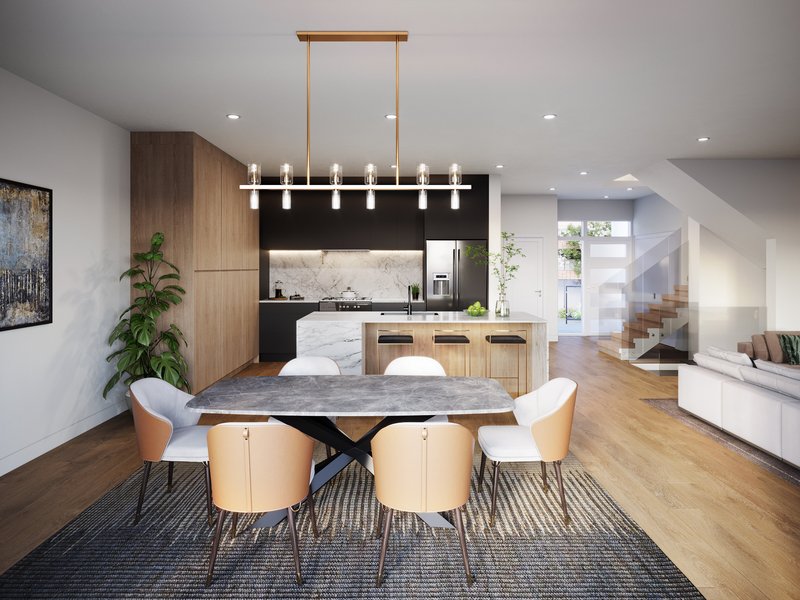Visualizing Your Dream Space: How 3D Rendering Bridges the Gap Between Clients and Interior Designers
The field of interior design is dynamic, often filled with creativity, innovation, and a constant quest for enhanced communication between designers and their clients. Visualizing ideas and concepts from designer to client has always been one of the core aspects of interior design. However, it has also been one of the most significant challenges. Traditionally, concepts that are crystal clear in a designer's mind can often seem abstract and obscure to clients with less experience in visualizing spaces. Today, thanks to 3D rendering technology, this communication gap is being bridged, and the client-designer relationship is being transformed for the better.
The Communication Gap in the Traditional Paradigm
In the traditional interior design process, conveying design concepts often relied heavily on physical blueprints, hand-drawn sketches, mood boards, or 2D digital drawings. These modes of representation require a lot of imagination by the client, as they attempt to construct a mental 3D model of the proposed design. Often, there is a disconnect between what the designer envisions and what the client understands from these presentations.
This communication gap can lead to misunderstandings that can cause dissatisfaction with the final product, unmet expectations, and even costly changes during the construction or remodelling phase. There's also the potential for a lot of back-and-forth as designers try to get into their client's heads and clients struggle to articulate their ideas and feedback.
The Game-Changing Power of 3D Rendering
Introducing 3D rendering has radically shifted this paradigm. This advanced technology enables designers to create hyper-realistic digital models of interior spaces, complete with furniture, lighting, textures, and colours. These renderings aren't just flat images; they are explorable, immersive models that clients can virtually 'walk' through, experiencing the space from every angle.
The advantage of this technology is twofold. First, it provides a more accurate and realistic representation of the space, making it easier for clients to understand the proposed design. Second, it allows clients to interact with the design, exploring it from different viewpoints, and even testing out different design options. This level of interaction is a massive leap forward in client-designer communication and is a game-changer in the industry.
The Crucial Role of Visualization

Visualization is a vital element in the world of design. When clients can see a vivid yet lifelike representation of the proposed design, they can better communicate their likes and dislikes, leading to a final design that more accurately reflects their desires and needs.
For instance, if a designer proposes a bold, innovative colour scheme or an unconventional furniture arrangement, these elements might seem risky or strange to the client in a 2D sketch. However, seeing them in a 3D rendering allows the client to visualize them in the overall design context. They can see how the colours interact with each other, how the light plays off the furniture, and how the space flows. This can help them feel more comfortable with innovative designs and makes them more likely to approve of adventurous ideas.
3D Rendering and Enhanced Collaboration
Beyond its benefits for visualization, 3D rendering also allows for enhanced collaboration between the designer and the client. With a 3D model, the client can point out changes they want to see, and the designer can make those adjustments in real time. This interactive, collaborative process reduces the risk of misunderstandings and unmet expectations, increasing client satisfaction.
This technology streamlines the design process, making it more efficient. Changes can be made to the 3D model at any stage, allowing the designer to experiment with different ideas before settling on the conclusive design. This flexibility reduces the risk of costly changes during the construction phase, saving both time and money for all involved.
The Democratization of Design through 3D Rendering
The rise of 3D rendering technology is not just enhancing communication between designers and clients. It is also democratizing the design process. It allows clients to be more active in designing their spaces, leading to a more personalized, client-centred approach. Clients can see their feedback directly applied to the design, helping them feel more invested and involved.
3D rendering is, therefore, not just a tool for visual communication; it's a tool for empowerment, giving clients a stronger voice in shaping their environments. It enhances the client-designer relationship, leading to better design outcomes and greater satisfaction for all parties.
Conclusion
In conclusion, 3D rendering is a revolutionary tool in interior design, bridging the gap between clients and designers. This technology enhances communication, collaboration, and efficiency by providing a realistic, interactive model of the proposed design. It enables designers to express their creative vision more effectively and clients to engage more deeply with the design process. As we look to the future, it's clear that 3D rendering will continue to transform the world of interior design, making it more accessible, collaborative, and exciting than ever before.
In the age of rapid technological advancements, the embrace of 3D rendering in interior design is a testament to the industry's adaptability and willingness to enhance the client experience. As this technology continues to evolve and become even more sophisticated, we can expect further transformations in interior design. The future promises even more detailed and realistic renderings, virtual reality walkthroughs, and perhaps even the integration of artificial intelligence for personalized design recommendations. These developments will continue to enhance the client-designer relationship and open up new possibilities for creative expression in interior design.
Our Services
View some of our most popular services below.











